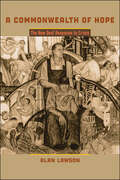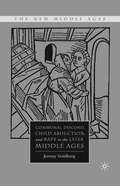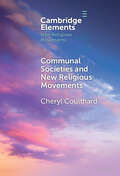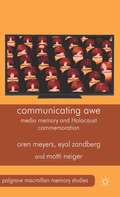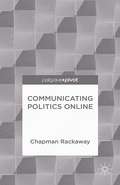- Table View
- List View
A Commonwealth of Hope: The New Deal Response to Crisis (The American Moment)
by Alan LawsonDid the New Deal represent the true American way or was it an aberration that would last only until the old order could reassert itself? This original and thoughtful study tells the story of the New Deal, explains its origins, and assesses its legacy. Alan Lawson explores how the circumstances of the Great Depression and the distinctive leadership of Franklin D. Roosevelt combined to bring about unprecedented economic and policy reform. Challenging conventional wisdom, he argues that the New Deal was not an improvised response to an unexpected crisis, but the realization of a unique opportunity to put into practice Roosevelt’s long-developed progressive thought. Lawson focuses on where the impetus and plans for the New Deal originated, how Roosevelt and those closest to him sought to fashion a cooperative commonwealth, and what happened when the impulse for collective unity was thwarted. He describes the impact of the Great Depression on the prevailing system and traces the fortunes of several major social sectors as the drive to create a cohesive plan for reconstruction unfolded. He continues the story of these main sectors through the last half of the 1930s and traces their legacy down to the present as crucial challenges to the New Deal have arisen. Drawing from a wide variety of scholarly texts, records of the Roosevelt administration, Depression-era newspapers and periodicals, and biographies and reflections of the New Dealers, Lawson offers a comprehensive conceptual base for a crucial aspect of American history.
The Communal Age in Western Europe, c.1100-1800: Towns, Villages and Parishes in Pre-Modern Society (Studies in European History)
by Beat KüminAn essential introductory survey of the towns, villages and parishes in which people lived in the medieval and early modern periods. Beat Kumin assesses the similarities, differences and the wider significance of these communities for European society prior to 1800.
Communal Discord, Child Abduction, and Rape in the Later Middle Ages (The New Middle Ages)
by J. GoldbergDid medieval women have the power to choose? This is a question at the heart of this book which explores three court cases from Yorkshire in the decades after the Black Death. Alice de Rouclif was a child heiress made to marry the illegitimate son of the local abbot and then abducted by her feudal superior. Agnes Grantham was a successful businesswoman ambushed and assaulted in a forest whilst on her way to dine with the Master of St Leonard's Hospital. Alice Brathwell was a respectable widow who attracted the attentions of a supposedly aristocratic conman. These are their stories.
Communal Intimacy and the Violence of Politics: Understanding the War on Drugs in Bagong Silang, Philippines
by Steffen Bo Jensen Karl HapalCommunal Intimacy and the Violence of Politics explores the notoriously brutal Philippine war on drugs from below. Steffen Bo Jensen and Karl Hapal examine how the war on drugs folded itself into communal and intimate spheres in one Manila neighborhood, Bagong Silang. Police killings have been regular occurrences since the birth of Bagong Silang. Communal Intimacy and the Violence of Politics shows that although the drug war was introduced from the outside, it fit into and perpetuated already existing gendered and generational structures. In Bagong Silang, the war on drugs implicated local structures of authority, including a justice system that had always been deeply integrated into communal relations. The ways in which the war on drugs transformed these intimate relations between the state and its citizens, and between neighbors, may turn out to be the most lasting impact of Duterte's infamously violent policies.
Communal Labor in Colonial Kenya: The Legitimization of Coercion, 1912–1930
by O. OkiaThis book advances research into the government-forced labor used widely in colonial Kenya from 1930 to 1963 after the passage of the International Labor Organization’s Forced Labour Convention. While the 1930 Convention intended to mark the suppression of forced labor practices, various exemptions meant that many coercive labor practices continued in colonial territories. Focusing on East Africa and the Kenya Colony, this book shows how the colonial administration was able to exploit the exemption clause for communal labor, thus ensuring the mobilization of African labor for infrastructure development. As an exemption, communal labor was not defined as forced labor but instead justified as a continuation of traditional African and community labor practices. Despite this ideological justification, the book shows that communal labour was indeed an intensification of coercive labor practices and one that penalized Africans for non-compliance with fines or imprisonment. The use of forced labor before and after the passage of the Convention is examined, with a focus on its use during World War II as well as in efforts to combat soil erosion in the rural African reserve areas in Kenya. The exploitation of female labor, the Mau Mau war of the 1950s, civilian protests, and the regeneration of communal labor as harambee after independence are also discussed.
Communal Societies and New Religious Movements (Elements in New Religious Movements)
by null Cheryl CoulthardPopular understanding of communal societies tends to focus on the 1960s hippie colonies and ignores the rich and long history of communalism in the United States. This Element corrects that misperception by exploring the synergy between new religious movements and communal living, including the benefits and challenges that grow out of this connection. It introduces definitions of key terms and vocabulary in the fields of new religious movements and communal studies. Discussion of major theories of communal success and the role of religion follows. The Element includes historical examples to demonstrate the ways in which new religious movements used communalism as a safe space to grow and develop their religion. The Element also analyzes why these groups have tended to experience conflicts with mainstream society.
Communal Utopias and the American Experience: Secular Communities, 1824-2000 (Non-ser.)
by Robert P. SuttonThis important study begins with America's first secular utopia at New Harmony in 1824 and traces successive utopian experiments in the United States through the following centuries. For the first time, readers will come to realize that American communalism is not a disjointed, erratic, almost ephemeral part of our past, but has been an on-going, essential part of American history. We have a communal utopian motif that sets the history of the United States apart from any other nation. The utopian communal story is just one other dimension of the Puritan concept that America was a city upon a hill, a beacon light to all the world where the perfect society could be built and could flourish.After discussing New Harmony and other Owenite communities, the author examines nine Fourierist utopias that were built before the Civil War. Next, he analyzes the five Icarian colonies that, collectively, were the longest-lived, non-religious communal experiments in American history. Then, discussion moves to the seven Gilded Age socialist cooperatives, followed by the utopian communities created during President Franklin D. Roosevelt's New Deal. Finally, Sutton turns to the hippie colonies and intentional communities of the last half of the 20th century.
Communal Violence in the British Empire: Disturbing the Pax
by Mark DoyleJoint winner of the North American Conference on British Studies 2017 Stansky Book Prize for the best book on British Studies since 1800Communal Violence in the British Empire focuses on how Britons interpreted, policed, and sometimes fostered violence between different ethnic and religious communities in the empire. It also asks what these outbreaks meant for the power and prestige of Britain among subject populations. Alternating between chapters of engaging narrative and chapters of careful, cross-colonial analysis, Mark Doyle uses outbreaks of communal violence in Ireland, the West Indies, and South Asia to uncover the inner workings of British imperialism: it's guiding assumptions, its mechanisms of control, its impact, and its limitations. He explains how Britons used communal violence to justify the imperial project even as that project was creating the conditions for more violence. Above all, this book demonstrates how communal violence exposed the limits of British power and, in time, helped lay the groundwork for the empire's collapse.This book shows how violence, and the British state's handling thereof, was a fundamental part of the imperial experience for colonizer and colonized alike. It offers a new perspective on the workings of empire that will be of interest to any student of imperial or world history.
Communal Violence in the British Empire: Disturbing the Pax
by Mark DoyleJoint winner of the North American Conference on British Studies 2017 Stansky Book Prize for the best book on British Studies since 1800Communal Violence in the British Empire focuses on how Britons interpreted, policed, and sometimes fostered violence between different ethnic and religious communities in the empire. It also asks what these outbreaks meant for the power and prestige of Britain among subject populations. Alternating between chapters of engaging narrative and chapters of careful, cross-colonial analysis, Mark Doyle uses outbreaks of communal violence in Ireland, the West Indies, and South Asia to uncover the inner workings of British imperialism: it's guiding assumptions, its mechanisms of control, its impact, and its limitations. He explains how Britons used communal violence to justify the imperial project even as that project was creating the conditions for more violence. Above all, this book demonstrates how communal violence exposed the limits of British power and, in time, helped lay the groundwork for the empire's collapse.This book shows how violence, and the British state's handling thereof, was a fundamental part of the imperial experience for colonizer and colonized alike. It offers a new perspective on the workings of empire that will be of interest to any student of imperial or world history.
Communalism and Sexual Violence in India: The Politics of Gender, Ethnicity and Conflict (Library of Development Studies)
by Megha KumarSexual violence has been a regular feature of communal conflict in India since independence in 1947. The Partition riots, which saw the brutal victimization of thousands of Hindu, Muslim and Sikh women, have so far dominated academic discussions of communal violence. This book examines the specific conditions motivating sexual crimes against women based on three of the deadliest riots that occurred in Ahmedabad city, Gujarat, in 1969, 1985 and 2002. Using an in-depth, grassroots-level analysis, Megha Kumar moves away from the predominant academic view that sees Hindu nationalist ideology as responsible for encouraging attacks on women. Instead, gendered communal violence is shown to be governed by the interaction of an elite ideology.
Communicating Awe: Media Memory and Holocaust Commemoration (Palgrave Macmillan Memory Studies)
by O. Meyers M. Neiger E. ZandbergOffering a cross-media exploration of Israeli media on Holocaust Remembrance Day, one of Israel's most sacred national rituals, over the past six decades, this fascinating book investigates the way in which variables such as medium, structure of ownership, genre and targeted audiences shape the collective recollection of traumatic memories.
Communicating Ice through Popular Art and Aesthetics (Palgrave Studies in Media and Environmental Communication)
by Anne Hemkendreis Anna-Sophie JürgensThis book brings together the perspectives of eminent and emerging scholars from fields as varied as science communication, art history, pop cultural studies, environmental studies, sciences studying ice and artists to explore the power of (popular) arts and aesthetics to communicate ice research and the urgency of environmental action. Examining the aesthetic strategies employed in images, (popular) visual fiction and narratives to convey meaning and awareness – and how they can be made fruitful for science communication – the project will generate new perspectives on how our collective environmental responsibility can be addressed and communicated across disciplines and divers audiences. In doing so, the volume will illuminate the cultural power of ice research and contribute to a better understanding of the cultural work that emerges from our ecological crisis.
Communicating India’s Soft Power: Buddha to Bollywood (Palgrave Macmillan Series in Global Public Diplomacy)
by D. ThussuIn recent years, India has emerged as a major economic and political power. Yet, the country's cultural influence outside India has not been adequately analyzed in academic discourses. This book, a pioneering attempt, from an international communication/media perspective, is aimed to fill the existing gap in scholarship in this area.
Communicating International Development (Rethinking Development Series (PDF))
by Florencia Enghel Jessica Noske-TurnerInternational development stakeholders harness communication with two broad purposes: to do good, via communication for development and media assistance, and to communicate do-gooding, via public relations and information. This book unpacks various ways in which different efforts to do good are combined with attempts to look good, be it in the eyes of donor constituencies at large, or among more specific audiences, such as journalists or intra-agency decision-makers. Development communication studies have tended to focus primarily on interventions aimed at doing good among recipients, at the expense of examining the extent to which promotion and reputation management are elements of those practices. This book establishes the importance of interrogating the tensions generated by overlapping uses of communication to do good and to look good within international development cooperation. The book is a critical text for students and scholars in the areas of development communication and international development and will also appeal to practitioners working in international aid who are directly affected by the challenges of communicating for and about development.
Communicating International Development (Rethinking Development Ser.)
by Florencia Enghel Jessica Noske-TurnerInternational development stakeholders harness communication with two broad purposes: to do good, via communication for development and media assistance, and to communicate do-gooding, via public relations and information. This book unpacks various ways in which different efforts to do good are combined with attempts to look good, be it in the eyes of donor constituencies at large, or among more specific audiences, such as journalists or intra-agency decision-makers. Development communication studies have tended to focus primarily on interventions aimed at doing good among recipients, at the expense of examining the extent to which promotion and reputation management are elements of those practices. This book establishes the importance of interrogating the tensions generated by overlapping uses of communication to do good and to look good within international development cooperation. The book is a critical text for students and scholars in the areas of development communication and international development and will also appeal to practitioners working in international aid who are directly affected by the challenges of communicating for and about development.
Communicating International Development (Rethinking Development Ser.) (PDF)
by Florencia Enghel Jessica Noske-TurnerInternational development stakeholders harness communication with two broad purposes: to do good, via communication for development and media assistance, and to communicate do-gooding, via public relations and information. This book unpacks various ways in which different efforts to do good are combined with attempts to look good, be it in the eyes of donor constituencies at large, or among more specific audiences, such as journalists or intra-agency decision-makers. Development communication studies have tended to focus primarily on interventions aimed at doing good among recipients, at the expense of examining the extent to which promotion and reputation management are elements of those practices. This book establishes the importance of interrogating the tensions generated by overlapping uses of communication to do good and to look good within international development cooperation. The book is a critical text for students and scholars in the areas of development communication and international development and will also appeal to practitioners working in international aid who are directly affected by the challenges of communicating for and about development.
Communicating Papal Authority in the Middle Ages (Studies in Medieval History and Culture)
by Minoru Ozawa Thomas W. Smith Georg StrackThis book bridges Japanese and European scholarly approaches to ecclesiastical history to provide new insights into how the papacy conceptualised its authority and attempted to realise and communicate that authority in ecclesiastical and secular spheres across Christendom. Adopting a broad, yet cohesive, temporal and geographical approach that spans the Early to the Late Middle Ages, from Europe to Asia, the book focuses on the different media used to represent authority, the structures through which authority was channelled and the restrictions that popes faced in so doing, and the less certain expression of papal authority on the edges of Christendom. Through twelve chapters that encompass key topics such as anti-popes, artistic representations, preaching, heresy, the crusades, and mission and the East, this interdisciplinary volume brings new perspectives to bear on the medieval papacy. The book demonstrates that the communication of papal authority was a two-way process effected by the popes and their supporters, but also by their enemies who helped to shape concepts of ecclesiastical power. Communicating Papal Authority in the Middle Ages will appeal to researchers and students alike interested in the relationships between the papacy and medieval society and the ways in which the papacy negotiated and expressed its authority in Europe and beyond.
Communicating Papal Authority in the Middle Ages (Studies in Medieval History and Culture)
by Minoru Ozawa Thomas W. Smith Georg StrackThis book bridges Japanese and European scholarly approaches to ecclesiastical history to provide new insights into how the papacy conceptualised its authority and attempted to realise and communicate that authority in ecclesiastical and secular spheres across Christendom. Adopting a broad, yet cohesive, temporal and geographical approach that spans the Early to the Late Middle Ages, from Europe to Asia, the book focuses on the different media used to represent authority, the structures through which authority was channelled and the restrictions that popes faced in so doing, and the less certain expression of papal authority on the edges of Christendom. Through twelve chapters that encompass key topics such as anti-popes, artistic representations, preaching, heresy, the crusades, and mission and the East, this interdisciplinary volume brings new perspectives to bear on the medieval papacy. The book demonstrates that the communication of papal authority was a two-way process effected by the popes and their supporters, but also by their enemies who helped to shape concepts of ecclesiastical power. Communicating Papal Authority in the Middle Ages will appeal to researchers and students alike interested in the relationships between the papacy and medieval society and the ways in which the papacy negotiated and expressed its authority in Europe and beyond.
Communicating Politics Online
by Chapman RackawayThe world of political communication is morphing almost constantly into new areas and realities. Online-only news, Web 2.0 user-created content, hyperlocal news, and the rise of the Twittersphere have all contributed to an ever-changing media environment. Communicating Politics Online captures the constant change of new online media.
Communicating the history of medicine: Perspectives on audiences and impact (Social Histories of Medicine)
by David CantorCommunicating the History of Medicine critically assesses the idea of audience and communication in medical history. This collection offers a range of case studies on academic outreach from historical and current perspectives. It questions the kind of linear thinking often found in policy or research assessment, instead offering a more nuanced picture of both the promises and pitfalls of engaging audiences for research in the humanities. For whom do academic researchers in the humanities write? For academics and, indirectly, at least for students, but there are hopes that work reaches broader audiences and that it will have an impact on policy or among professional experts outside of the humanities. Today impact is more and more discussed in the context of research assessment. Seen from a media theoretical perspective, impact may however be described as a case of ‘audiencing’ and the creation of audiences by means of media technologies.
Communicating the history of medicine: Perspectives on audiences and impact (Social Histories of Medicine)
by Sven Widmalm Solveig JülichCommunicating the History of Medicine critically assesses the idea of audience and communication in medical history. This collection offers a range of case studies on academic outreach from historical and current perspectives. It questions the kind of linear thinking often found in policy or research assessment, instead offering a more nuanced picture of both the promises and pitfalls of engaging audiences for research in the humanities. For whom do academic researchers in the humanities write? For academics and, indirectly, at least for students, but there are hopes that work reaches broader audiences and that it will have an impact on policy or among professional experts outside of the humanities. Today impact is more and more discussed in the context of research assessment. Seen from a media theoretical perspective, impact may however be described as a case of ‘audiencing’ and the creation of audiences by means of media technologies.
Communicating the Middle Ages: Essays in Honour of Sophia Menache (Crusades - Subsidia)
by Iris Shagrir Benjamin Kedar Michel BalardThis volume is a collection of nineteen original essays by leading specialists on the history, historiography and memory of the Crusades, the social and cultural aspects of life in the Latin East, as well as the military orders and inter-religious relations in the Middle Ages. Intended to appeal to scholars and students alike, the volume honours Professor Sophia Menache of the Department of History, University of Haifa, Israel. The contributions reflect the richness of Professor Menache's research interests - medieval communications, the Church and the Papacy in the central and later Middle Ages, the Crusades and the military orders, as well as the memory and historiography of the Crusades.
Communicating the Middle Ages: Essays in Honour of Sophia Menache (Crusades - Subsidia)
by Iris Shagrir Benjamin Z. Kedar Michel BalardThis volume is a collection of nineteen original essays by leading specialists on the history, historiography and memory of the Crusades, the social and cultural aspects of life in the Latin East, as well as the military orders and inter-religious relations in the Middle Ages. Intended to appeal to scholars and students alike, the volume honours Professor Sophia Menache of the Department of History, University of Haifa, Israel. The contributions reflect the richness of Professor Menache's research interests - medieval communications, the Church and the Papacy in the central and later Middle Ages, the Crusades and the military orders, as well as the memory and historiography of the Crusades.
Communicating the North: Media Structures and Images in the Making of the Nordic Region (The Nordic Experience)
by Peter StadiusWhat makes a magazine in South Africa promote Scandinavian unity among its immigrant readers and why does a Swedish king endorse attempts to influence pan-Scandinavian opinion through a transnational media event in Sweden, Norway and Denmark? Can portraits of exotic Lapplanders in the British press, enthusiastic accounts of the welfare state in post-war travel literature and descriptions of the liberal Nordic woman as a metaphor for a freer society in Franco Spain really be bundled together under a joint label of 'Nordicness'? How is it that despite the variety of images of the Nordic region that are circulating, we still find this recurring idea of a shared Nordic identity? These are some of the questions the current volume seeks to answer. Covering the time period from the early nineteenth century up until the present and encompassing case studies from Britain, Spain, Poland, and South Africa, as well as from the Nordic countries, contributors to the volume investigate the images that have been presented of the Nordic region in the media in and outside of the Nordic countries, how such images have been shaped by mechanisms of mediation, and the channels through which they have been distributed. The chapters address both specific cases such as media events and individual publications, as well as the structural and institutional settings for mediating the Nordic region.
Communicating the North: Media Structures and Images in the Making of the Nordic Region (The Nordic Experience)
by Peter StadiusWhat makes a magazine in South Africa promote Scandinavian unity among its immigrant readers and why does a Swedish king endorse attempts to influence pan-Scandinavian opinion through a transnational media event in Sweden, Norway and Denmark? Can portraits of exotic Lapplanders in the British press, enthusiastic accounts of the welfare state in post-war travel literature and descriptions of the liberal Nordic woman as a metaphor for a freer society in Franco Spain really be bundled together under a joint label of 'Nordicness'? How is it that despite the variety of images of the Nordic region that are circulating, we still find this recurring idea of a shared Nordic identity? These are some of the questions the current volume seeks to answer. Covering the time period from the early nineteenth century up until the present and encompassing case studies from Britain, Spain, Poland, and South Africa, as well as from the Nordic countries, contributors to the volume investigate the images that have been presented of the Nordic region in the media in and outside of the Nordic countries, how such images have been shaped by mechanisms of mediation, and the channels through which they have been distributed. The chapters address both specific cases such as media events and individual publications, as well as the structural and institutional settings for mediating the Nordic region.
